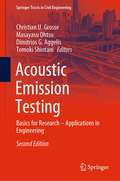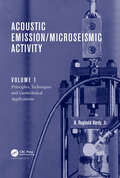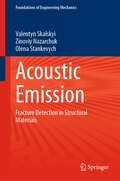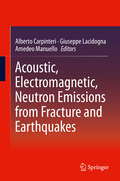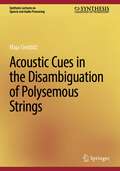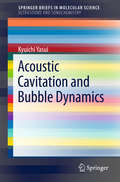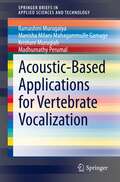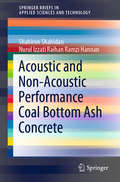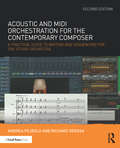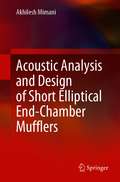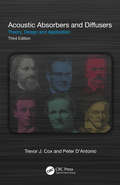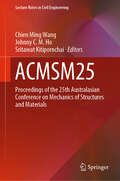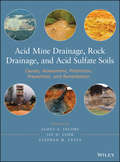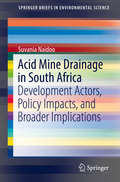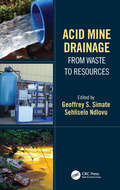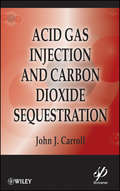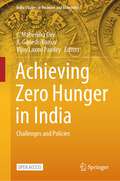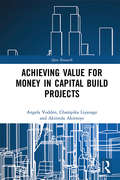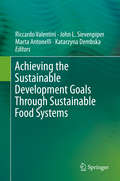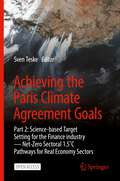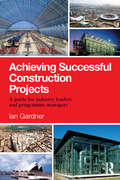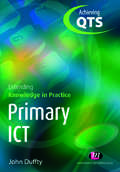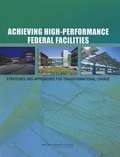- Table View
- List View
Acoustic Emission Testing: Basics for Research – Applications in Engineering (Springer Tracts in Civil Engineering)
by Christian U. Grosse Masayasu Ohtsu Dimitrios G. Aggelis Tomoki ShiotaniThis book provides an introduction to Acoustic Emission Testing and its applications to different materials like concrete, steel, ceramics, geotechnical materials, polymers, biological structures and wood. Acoustic Emission Techniques (AET) techniques have been studied in engineering for a long time. The techniques are applied more and more to practical investigations and are more and more standardized in codes. This is because the degradation of structures due to ageing urgently demand for maintenance and rehabilitation of structures in service. It results in the need for the development of advanced and efficient inspection techniques. In mechanical engineering and concerning the monitoring of machines and mechanical components, AE is a widely accepted observing deterioration in the frame of structural health monitoring. The advantages of AE like sensitivity, damage localization potential, non-intrusive nature as well as developments in signal analysis and data transmission allow applications that could not be considered decades ago.As such, AE techniques draw great attention to diagnostic applications and in material testing. This book covers all levels from the description of AE basics for AE beginners (level of a student) to sophisticated AE algorithms and applications to real large-scale structures as well as the observation of the cracking process in laboratory specimen to study fracture processes. This book has proved its worth over the past twelve years. Now in its second edition, it will be a resource that sets the standard and equips readers for the future. All chapters from the 1st edition have been updated and rewritten and eight extra chapters (e.g also regarding AE tomography, AE in plate-like structures and AE for investigations of hardening of fresh concrete) have been added.
Acoustic Emission/Microseismic Activity: Volume 1: Principles, Techniques and Geotechnical Applications
by Jr., H. HardyA study of topics related to acoustic emission/microseismic (AE/MS) activity. It covers basic material behaviour, stress wave propagation, transducer design and installation, electronic instrumentation, data acquisition and analysis, and signal processing, as well as practical applications.
Acoustic Emission: Fracture Detection in Structural Materials (Foundations of Engineering Mechanics)
by Valentyn Skalskyi Zinoviy Nazarchuk Olena StankevychThe book presents topical theoretical and experimental studies for developing advanced methods of detecting materials fracture and assessing their structural state using acoustic emission. It introduces new mathematical models characterizing the displacement fields arising from crack-like defects and establishes a new criterion for classifying different types of materials fracture based on specific parameters obtained from wavelet transforms of acoustic emission signals. The book applies this approach to experimental studies in three types of materials—fiber-reinforced composites, dental materials, and hydrogen-embrittled steels.
Acoustic, Electromagnetic, Neutron Emissions from Fracture and Earthquakes
by Alberto Carpinteri Giuseppe Lacidogna Amedeo ManuelloThis book presents the relevant consequences of recently discovered and interdisciplinary phenomena, triggered by local mechanical instabilities. In particular, it looks at emissions from nano-scale mechanical instabilities such as fracture, turbulence, buckling and cavitation, focussing on vibrations at the TeraHertz frequency and Piezonuclear reactions. Future applications for this work could include earthquake precursors, climate change, energy production and cellular biology. A series of fracture experiments on natural rocks demonstrates that the TeraHertz vibrations are able to induce fission reactions on medium weight elements accompanied by neutron emissions. The same phenomenon appears to have occurred in several different situations, particularly in the chemical evolution of the Earth and Solar System, through seismicity (rocky planets) and storms (gaseous planets). As the authors explore, these phenomena can also explain puzzles related to the history of our planet, like the ocean formation or the primordial carbon pollution, as well as scientific mysteries, like the so-called "cold nuclear fusion" or the correct radio-carbon dating of organic materials, such as the Turin Shroud. In biology, Piezonuclear reactions could explain the mechanism that governs the so-called "sodium-potassium pump" and more in general, the metabolic processes. Scientists engaged in seismology, geophysics, geochemistry, climatology, planetology, condensed matter physics and b iology, as well as those involved in theoretical and applied mechanics, will all appreciate the innovative work presented here in a holistic way.
Acoustic Cues in the Disambiguation of Polysemous Strings (Synthesis Lectures on Speech and Audio Processing)
by Maja GwóźdźThis book provides an analysis of acoustic features of polysemous strings and an implementation of a speech disambiguation program based on the phonetic information. Throughout the book, the term ‘polysemous string’ refers to idioms with plausible literal interpretations, restrictive and non–restrictive relative clauses, and the same expressions used as quotations and appearing in a non–quotational context. The author explains how, typically, context is sufficient to determine the intended meaning. But there is enough evidence in psycholinguistic and phonetic literature to suspect that these superficially identical strings exhibit different acoustic features. In the experiment presented in the book, the participants were asked to read short excerpts containing corresponding elements of polysemous strings placed in the same intonational position. The acoustic analyses of ditropic pairs and subsequent statistical tests revealed that there is almost no difference in the duration, pitch, or intensity in literal and figurative interpretations. However, the analysis of relative clauses and quotations demonstrated that speakers are more likely to use acoustic cues to differentiate between the two possible readings. The book argues that the acoustic analysis of polysemous phrases could be successfully implemented in designing automatic speech recognition systems in order to improve their performance in disambiguating polysemous phrases.Analyzes acoustic features of polysemous strings and an implementation of a speech disambiguation programIncludes evidence that superficially identical strings exhibit different acoustic featuresArgues that acoustic analysis of polysemous phrases can be successfully implemented in automatic speech recognition
Acoustic Cavitation and Bubble Dynamics (SpringerBriefs in Molecular Science)
by Kyuichi YasuiThis brief explains in detail fundamental concepts in acoustic cavitation and bubble dynamics, and describes derivations of the fundamental equations of bubble dynamics in order to support those readers just beginning research in this field. Further, it provides an in-depth understanding of the physical basis of the phenomena. With regard to sonochemistry, the brief presents the results of numerical simulations of chemical reactions inside a bubble under ultrasound, especially for a single-bubble system and including unsolved problems. Written so as to be accessible both with and without prior knowledge of fundamental fluid dynamics, the brief offers a valuable resource for students and researchers alike, especially those who are unfamiliar with this field. A grasp of fundamental undergraduate mathematics such as partial derivative and fundamental integration is advantageous; however, even without any background in mathematics, readers can skip the e quations and still understand the fundamental physics of the phenomena using the book's wealth of illustrations and figures. As such, it is also suitable as an introduction to the field.
Acoustic-Based Applications for Vertebrate Vocalization (SpringerBriefs in Applied Sciences and Technology)
by Ramashini Murugaiya Manisha Milani Mahagammulle Gamage Krishani Murugiah Madhumathy PerumalAcoustic-Based Applications for Vertebrate Vocalization is designed to help researchers improve their findings and knowledge of vertebrate vocalization by focusing on the integration of acoustic features with new technologies, such as the Internet of Things (IoT), cloud computing, and virtual and cognitive reality. The book addresses the most common challenges in vertebrate vocalization-based research via suitable audio signal processing techniques, data collection, data pre-processing, acoustic feature engineering, extraction, and selection for multidisciplinary applications, i.e. feature classification, vertebrate communication, behavioral analysis, and signal pattern analysis. The book is an important reference for scholars, researchers, industry practitioners, teachers, and students across a number of disciplines, including bioengineering, audio engineering, systems engineering, biotechnology, signal processing, biology, zoology, and animal sciences.
Acoustic And Non-Acoustic Performance Coal Bottom Ash Concrete (SpringerBriefs in Applied Sciences and Technology)
by Shahiron Shahidan Nurul Izzati Raihan Ramzi HannanThis book highlights the acoustic performance of concrete made with Coal Bottom Ash (CBA) that has contributed to environmental issues. The usage of CBA in concrete can be recommended as good concrete due to its absorption properties. This book focuses on the principles and techniques employed in acoustic design. The book first elaborates on the perception of noise and properties of noise, followed by physical data, units and measurements. Finally, it takes a look at acoustic analysis which includes acoustic performance effects using different volumes of CBA, density and porosity of concrete.
Acoustic and MIDI Orchestration for the Contemporary Composer: A Practical Guide to Writing and Sequencing for the Studio Orchestra
by Andrea Pejrolo Richard DeRosaAcoustic and MIDI Orchestration for the Contemporary Composer, Second Edition provides effective explanations and illustrations to teach you how to integrate traditional approaches to orchestration with the use of the modern sequencing techniques and tools available to today’s composer. By covering both approaches, Pejrolo and DeRosa offer a comprehensive and multifaceted learning experience that will develop your orchestration and sequencing skills and enhance your final productions. A leading manual on its subject, the second edition allows experienced composers and producers to be exposed to sequencing techniques applied to traditional writing and arranging styles. The book continues to provide a comprehensive and solid learning experience and has been fully revised to include the latest tools and techniques. The new edition has been updated to include: A new chapter on cover writing and sequencing for vocal ensembles Coverage of writing for different ensemble sizes A new final chapter on writing and production techniques for mixed contemporary ensembles. All new techniques, tools, and sound libraries available to today’s composer. A companion website (www.routledge.com/cw/pejrolo) includes a wide selection of audio examples, templates, sounds, and videos showcasing operational processes, allows you the opportunity to listen to the techniques discussed within the book.
Acoustic Analysis and Design of Short Elliptical End-Chamber Mufflers
by Akhilesh MimaniThis book presents a three-dimensional analysis of acoustic wave propagation in an elliptical waveguide, and applies the equations and concepts to design axially short elliptical end-chamber muffler configurations which are an important component of a complex multi-pass muffler used in a modern-day automotive exhaust system. A general solution of the Helmholtz equation in elliptical cylindrical co-ordinates is presented in terms of the Mathieu and modified Mathieu modal functions. This is followed by the tabulation and analysis, for the first time, of the non-dimensional resonance frequencies of the transverse modes of a rigid-wall elliptical waveguide for a complete range of aspect ratio. The modal shape patterns of the first few circumferential, radial and cross-modes are examined with particular attention to the pressure nodal ellipses and hyperbolae. An analytical formulation is then outlined for characterizing a single-inlet and single-outlet elliptical muffler with the inlet located on the end face and the outlet located either on the end face or side-surface. The ensuing chapter is devoted toward analyzing the Transmission Loss (TL) performance of different short end-chamber mufflers, namely (a) the straight-flow configuration having ports located on the opposite face, (b) the flow-reversal configuration with ports located on the same end face and (c) configuration with inlet port on the end face and outlet on the side surface. Design guidelines are formulated in terms of the optimal location of inlet and outlet ports which suppresses the deteriorating influence of certain higher-order modes, thereby delivering a broadband TL performance. Directions for future work are discussed toward the end. In summary, this book is a one-stop solution for a practicing automotive engineer designing mufflers, for an applied mathematician studying wave propagation in elliptical geometries, and also as a niche area within noise control engineering.
Acoustic Absorbers and Diffusers: Theory, Design and Application
by Trevor Cox Peter D’AntonioThis definitive guide covers the design and application of absorbers and diffusers in acoustics. Surface diffusion is a relatively young subject area, and diffuser design, application and characterisation are often not well understood. Although there is greater knowledge of absorption, it is also informed by new research. As two of the main design tools for altering the acoustic conditions of rooms, the correct use of absorbers and diffusers is important to the creation of quality acoustics. This text details the evolution and the current state of the art in diffuser and absorber research and application. It covers a range of practical and theoretical aspects, with extensive examples of installations and case studies to cater to practitioners working in the measurement, modelling and design of rooms, semi-enclosed spaces as well as in noise control. It is also invaluable for students and researchers wanting a grounding in acoustic treatment, as well as understanding the latest developments. All chapters have been revised and brought up to date in this new edition, with new applications, absorbers and diffusers featured. Sustainability, portable vocal booths, and fast time domain models for diffusers are just a few of the new sections. Improved techniques for measurement and prediction are included, as well as bringing old methods up-to-date with the latest refinements from standards and research. Most of the prediction methods in the book are now linked to open source implementations and downloadable MATLAB scripts, enabling readers to exploit the knowledge in this book more readily in design and research.
ACMSM25: Proceedings of the 25th Australasian Conference on Mechanics of Structures and Materials (Lecture Notes in Civil Engineering #37)
by Chien Ming Wang Johnny C. M. Ho Sritawat KitipornchaiThis book presents articles from The Australasian Conference on the Mechanics of Structures and Materials (ACMSM25 held in Brisbane, December 2018), celebrating the 50th anniversary of the conference. First held in Sydney in 1967, it is one of the longest running conferences of its kind, taking place every 2–3 years in Australia or New Zealand. Bringing together international experts and leaders to disseminate recent research findings in the fields of structural mechanics, civil engineering and materials, it offers a forum for participants from around the world to review, discuss and present the latest developments in the broad discipline of mechanics and materials in civil engineering.
Acid Mine Drainage, Rock Drainage, and Acid Sulfate Soils
by James A. Jacobs Jay H. Lehr Stephen M. TestaProvides the tools needed to analyze and solve acid drainage problemsFeaturing contributions from leading experts in science and engineering, this book explores the complex biogeochemistry of acid mine drainage, rock drainage, and acid sulfate soils. It describes how to predict, prevent, and remediate the environmental impact of acid drainage and the oxidation of sulfides, offering the latest sampling and analytical methods. Moreover, readers will discover new approaches for recovering valuable resources from acid mine drainage, including bioleaching.Acid Mine Drainage, Rock Drainage, and Acid Sulfate Soils reviews the most current findings in the field, offering new insights into the underlying causes as well as new tools to minimize the harm of acid drainage:Part I: Causes of Acid Mine Drainage, Rock Drainage and Sulfate Soils focuses on the biogeochemistry of acid drainage in different environments.Part II: Assessment of Acid Mine Drainage, Rock Drainage and Sulfate Soils covers stream characterization, aquatic and biological sampling, evaluation of aquatic resources, and some unusual aspects of sulfide oxidation.Part III: Prediction and Prevention of Acid Drainage discusses acid-base accounting, kinetic testing, block modeling, petrology, and mineralogy studies. It also explains relevant policy and regulations.Part IV: Remediation of Acid Drainage, Rock Drainage and Sulfate Soils examines both passive and active cleanup methods to remediate acid drainage.Case studies from a variety of geologic settings highlight various approaches to analyzing and solving acid drainage problems. Replete with helpful appendices and an extensive list of web resources, Acid Mine Drainage, Rock Drainage, and Acid Sulfate Soils is recommended for mining engineers and scientists, regulatory officials, environmental scientists, land developers, and students.
Acid Mine Drainage in South Africa: Development Actors, Policy Impacts, and Broader Implications (SpringerBriefs in Environmental Science)
by Suvania NaidooThis SpringerBrief focuses on Acid Mine Drainage (AMD) in the three basins in the Witwatersrand, South Africa. It provides a background to AMD and its impactsfrom a social science perspective. The South African government and non-governmental organizations' response to AMD is assessed, as well the socio-economic and developmental effects of AMD. This volume, which is based on the author's Master's dissertation at UNISA, involves interviews with a range of experts in the field from government departments, environmental organisations (activists), the private sector (mining), tourism sector and the agricultural sector. The book discusses existing policy documents on AMD and provides recommendations in response to the many socio-economic impacts which have not been fully addressed. A literature review on the global context of AMD is provided. South Africa's water systems are already severely harmed by climate change, different forms of pollution, and poorly managed sanitation systems. For these reasons, the country is becoming increasingly water-stressed and therefore, water will continue to become much scarcer in the future. As a result of AMD's continued impact on South Africa's water systems, as a technical or scientific matter as well as the policy implications for the mining sector, water security and socio-economic sustainability has become a highly contested issue.
Acid Mine Drainage: From Waste to Resources
by Geoffrey S. Simate Sehliselo NdlovuAcid mine drainage (AMD) is essentially the flow of water polluted with metals and other substances from existing/old mining areas and is considered to be one of the sources of pollution. A wide range of technologies are available for preventing AMD generation and/or treating AMD before discharge, but there is a shift towards recovery of industrially useful materials and products from AMD. Acid Mine Drainage: From Waste to Resources explores novel methods developed for the reuse and/or recovery of industrially useful materials from AMD including discussing generation, prediction, prevention, and remediation processes. It includes legislation and policy frameworks governing AMD and its environmental/health impacts. Provides a detailed overview of the mining operations and discusses the geochemical and hydrogeological context of acid mine drainage AMD formation, prediction and impact Presents a holistic approach to AMD generation, prediction, prevention, and remediation processes Presents exclusive material on reuse, recycling, and recovery of industrially useful materials from AMD Gives a detailed overview of the legislation and policy regulatory framework governing the management of AMD Analyses the effects of AMD on the environment and health This volume is aimed at researchers and professionals in metallurgical engineering, chemical engineering, environmental engineering, and mining engineering, including policy makers.
Acid Gas Injection and Carbon Dioxide Sequestration
by John J. CarrollProvides a complete treatment on two of the hottest topics in the energy sector - acid gas injection and carbon dioxide sequestration This book provides the most comprehensive and up-to-date coverage of two techniques that are rapidly increasing in importance and usage in the natural gas and petroleum industry - acid gas injection and carbon dioxide sequestration. The author, a well-known and respected authority on both processes, presents the theory of the technology, then discusses practical applications the engineer working in the field can implement. Both hot-button issues in the industry, these processes will help companies in the energy industry "go green," by creating a safer, cleaner environment. These techniques also create a more efficient and profitable process in the plant, cutting waste and making operations more streamlined. This outstanding new reference includes: Uses of acid gas injection, the method of choice for disposing of small quantities of acid gas Coverage of technologies for working towards a zero-emission process in natural gas production A practical discussion of carbon dioxide sequestration, an emerging new topic, often described as one of the possible solutions for reversing global warming Problems and solutions for students at the graduate level and industry course participants
Achieving Zero Hunger in India: Challenges and Policies (India Studies in Business and Economics)
by S. Mahendra Dev A. Ganesh-Kumar Vijay Laxmi PandeyThis open access volume discloses rich set of findings and policy recommendations for India towards achieving the SDG 2.1 target of zero hunger by 2030. Through its fourteen chapters, it takes an integrated approach by examining diverse aspects of food and nutrition security through multidisciplinary lens of Agricultural Economics, Nutrition, Crop Sciences, Anthropology and Law, while being rooted in economics. The chapters reflect this diversity in disciplines in terms of the questions posed, the data sets used, and the methodologies followed. Starting from the evolution of policy response for hunger and nutrition security, the book covers aspects such gender budgeting, dietary diversity, women’s empowerment, calorie intake norms, socio-legal aspects of right to health, subjective wellbeing, bio-fortification, crop insurance and food security linkages, interdependence of public distribution system (for food security) and employment guarantee schemes especially during COVID-19 pandemic, effects of dairy dietary supplements, and so on. With its rich discussions, the book is compelling for students, researchers, policy makers, development professionals and practitioners working in areas of food and nutrition security, SDGs, in particular SDG1, SDG2 and SDG5, and sustainable food systems.
Achieving Value for Money in Capital Build Projects (Spon Research)
by Angela Vodden Champika Liyanage Akintola AkintoyeThis book is the first to bring together academic and practitioner views of Value for Money (VFM). VFM has been used to assess whether or not an organisation has obtained the maximum benefit within the resources available to it. A concept used by the public sector to assess the benefits of major built environment projects, it has become a major tenet of public private partnerships, capital project infrastructure and civil engineering megaprojects. This book presents and discusses the various debates surrounding the concept of Value for Money. It provides an international perspective on VFM by drawing upon the existing and fast developing body of principles and practices for Capital Build Projects. Readers will gain a level of understanding of the issues involved, the challenges, opportunities and the support mechanisms and protocols required for implementation of VFM in capital building development. Ultimately, the book presents a protocol that has been developed to track and monitor the VFM of a capital project from day 1, an Equilibrium Testing Mechanism (ETM) developed by the authors. This testing mechanism allows each of the parties to a project to monitor their VFM position at any given stage of a project from the beginning to the end of the build stage and beyond as necessary. This book is both a useful reference for researchers and a practical guide for the construction and engineering industry.
Achieving the Sustainable Development Goals Through Sustainable Food Systems (Food And Health Ser.)
by Riccardo Valentini John L. Sievenpiper Marta Antonelli Katarzyna DembskaThis publication offers a systemic analysis of sustainability in the food system, taking as its framework the Sustainable Development Goals of the 2030 Agenda of the United Nations. Targeted chapters from experts in the field cover main challenges in the food system and propose methods for achieving long term sustainability. Authors focus on how sustainability can be achieved along the whole food chain and in different contexts. Timely issues such as food security, climate change and migration and sustainable agriculture are discussed in depth. The volume is unique in its multidisciplinary and multi-stakeholder approach. Chapter authors come from a variety of backgrounds, and authors include academic professors, members of CSO and other international organizations, and policy makers. This plurality allows for a nuanced analysis of sustainability goals and practices from a variety of perspectives, making the book useful to a wide range of readers working in different areas related to sustainability and food production. The book is targeted towards the academic community and practitioners in the policy, international cooperation, nutrition, geography, and social sciences fields. Professors teaching in nutrition, food technology, food sociology, geography, global economics, food systems, agriculture and agronomy, and political science and international cooperation may find this to be a useful supplemental text in their courses.
Achieving the Paris Climate Agreement Goals: Part 2: Science-based Target Setting for the Finance industry — Net-Zero Sectoral 1.5˚C Pathways for Real Economy Sectors
by Sven TeskeThis open access book is designed as a continuation of the editor’s 2019 book Achieving the Paris Climate Agreement Goals. This volume provides an in-depth analysis of industry sectors globally, and its purpose is to present emission reduction targets in 5-year steps (2025 to 2050) for the main twelve finance sectors per the Global Industry Classification System. This scientific analysis aims to support the United Nations Principles for Responsible Investment initiative to give sustainability guidance for the global finance industry. The industry sector pathways presented here are based on the latest global and regional 100% renewable energy and non-energy greenhouse gas Representative Concentration Pathways in order to keep climate change significantly under +1.5 C and thereby achieve the Paris Climate Agreement goals. The heart of this book is three chapters presenting the results of industry scenario modelling. These chapters cover twelve industry and service sectors as well as transportation and buildings. The specific energy demand and specific emissions are presented based on the emission accounting concept of “Scope 1, Scope 2 and Scope 3” emission pathways. This methodology has been developed to measure the climate and sustainability index for companies, and this research project expands the methodology to apply it to entire industry sectors. The results presented here are the first overall industry assessments under Scope 1, 2 and 3 from 2020 through 2050. The base for the energy pathways is the scenarios scenarios published in the previous volume. The nonenergy GHG emission scenarios, broken down to agriculture & forestry and industry, are detailed and include all major greenhouse gases and aerosols. The final section of the book presents the main conclusions of the industry pathway development work and recommendations for the finance industry and policy makers. Additionally, future qualitative future investment requirements in specific technologies and measures are presented.
Achieving Successful Construction Projects: A Guide for Industry Leaders and Programme Managers
by Ian GardnerWhether a construction project turns out to be successful or not has a lot to do with the clarity of the client’s objectives and how the client establishes and instils a culture throughout the project team. This book's focus is on defining and exploring those attributes of clients or organisations which enable clear communication, and as a result help ensure the project's success. For senior construction professionals, this book explains how to approach key aspects of projects so that the client's expectations can be anticipated and understood. It also provides information on how other parties can positively influence the outcome of the project and interact with their fellow stakeholders. Commentaries on real life projects illustrate how this is achieved in practice, and common pitfalls are pointed out to help you avoid them. Drawing on almost 40 years’ UK and international experience of working on major construction projects in a variety of roles, the author provides clear insight into how to efficiently progress a project from inception through to completion. This is hugely valuable reading for client senior decision-makers, project managers, programme managers, design and construction leaders, and those studying all of these subjects.
Achieving QTS Extending Knowledge in Practice: Extending Knowledge In Practice (Achieving QTS Extending Knowledge in Practice LM Series)
by John DufftyStill the biggest concern for many on initial teacher training courses is the acquisition of subject knowledge and the ability to translate that into effective teaching. This book addresses this - building on the core subject knowledge covered in the Achieving QTS series and relating it to classroom practice. It supports trainees in extending and deepening their knowledge of ICT and demonstrating how to apply it to planning and implementing lessons. Practical and up-to-date teaching examples are used to clearly contextualize subject knowledge. A clear focus on classroom practice helps trainees to build confidence and develop their own teaching strategies.
Achieving QTS
by John Sharp Jenny ByrneThis book supports trainees on primary initial teacher training courses where a secure knowledge and understanding of science is required for the award of Qualified Teacher Status (QTS). A rigorous test enables trainees to identify their strengths and weaknesses in science and this can be revisited in order to monitor and evaluate progress towards QTS. Trainees are able to direct their studies more usefully and quickly develop confidence in topics they find difficult. This edition is fully up to date with the 2007 QTS Standards.
Achieving High-Performance Federal Facilities: Strategies and Approaches for Transformational Change
by Committee on High-Performance Green Federal Buildings: Strategies Approaches for Meeting Federal ObjectivesThe design, construction, operation, and retrofit of buildings is evolving in response to ever-increasing knowledge about the impact of indoor environments on people and the impact of buildings on the environment. Research has shown that the quality of indoor environments can affect the health, safety, and productivity of the people who occupy them. Buildings are also resource intensive, accounting for 40 percent of primary energy use in the United States, 12 percent of water consumption, and 60 percent of all non-industrial waste. The processes for producing electricity at power plants and delivering it for use in buildings account for 40 percent of U. S. greenhouse gas emissions. The U. S. federal government manages approximately 429,000 buildings of many types with a total square footage of 3. 34 billion worldwide, of which about 80 percent is owned space. More than 30 individual departments and agencies are responsible for managing these buildings. The characteristics of each agency's portfolio of facilities are determined by its mission and its programs. In 2010, GSA's Office of Federal High-Performance Green Buildings asked the National Academies to appoint an ad hoc committee of experts to conduct a public workshop and prepare a report that identified strategies and approaches for achieving a range of objectives associated with high-performance green federal buildings. Achieving High-Performance Federal Facilities identifies examples of important initiatives taking place and available resources. The report explores how these examples could be used to help make sustainability the preferred choice at all levels of decision making. Achieving High-Performance Federal Facilities can serve as a valuable guide federal agencies with differing missions, types of facilities, and operating procedures.
Achieving Excellence in Business: A Practical Guide on the Total Quality Transformation Process (Quality And Reliability Ser. #27)
by Kenneth E. EbelThis volume provides the understanding and the means needed to achieve complete systematic quality control of goods and services in any type of organisation. It also shows how to meet or exceed clients' quality expectations, structure management systems to encourage business growth and adapt to changing needs, ensure continuous quality improvement and increase efficiency and effectiveness. The book explains the theory of total quality and demonsrates its practical applications, elucidates the relationships among all company departments and their effects on pursuit of excellence and presents several powerful problem solving techniques. An essential resource for quality improvement, quality control, business, human resource and industrial engineering managers, chief executive officers of product and service orientated firms and graduates in these disciplines.
